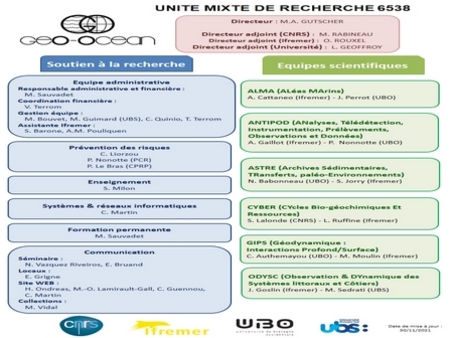Fluids / plumes team
The fluids/plumes team uses the CTD rosette equipped with 16 sample bottles to conduct on-board continuous real-time measures.
The aim is to detect hydrothermal plumes on a regional scale based on chemical (manganese or methane content) and physical (quantity of particles, temperature...) in the water column. The group is also in charge of the scientific instruments on-board the Nautile for the study of hydrothermal fluids and the plumes near to vents.
The CTD rosette is generally deployed when off (on station), although in certain cases it is towed slowly by the ship whilst going vertically back and forth in a yoyo movement. During the Hermine expedition, the profiles conducted during yoyo movements will enable to map a hydrothermal plume to a height of 500 m above the seabed. These samples will be analysed in a chemical lab where the gases are separated from the seawater. A high content is methane and/or hydrogen may indicate hydrothermal activity. Chromatographs are able to measure minute traces of methane and the results obtained will help to determine the strategy to adopt for future operations.
Once the source is detected, the team will use the titanium bottles manipulated by the arm of the Nautile, in-situ analysers and water samplers to collect hydrothermal fluids directly at the hydrothermal vent. Titanium is very resistant to the harshness of these extremely hot (more than 350°C) and acid fluids rich in metals and gas. Certain gas and chemic
The team also works in collaboration with the biologists on the study of the hydrothermal plume. A mooring has been installed near a hydrothermal field for a 1-year period to study the direction of currents and the chemical flux of hydrothermal plumes into the ocean.
- Jean-Pierre Donval, chemical fluid engineer, Ifremer
- Vivien Guyader, CTD and fluid chemistry technician, Ifremer
- Yoan Germain, chemist/technician, Ifremer
- Mickael Roudaut, machinist/technician, Ifremer
- Nicolas Gayet, biologist, Ifremer
- Agathe Laes, chemist/engineer, Ifremer
- Laurent Bignon, machinist/technician, Ifremer

